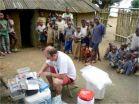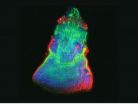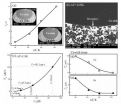(Press-News.org) Two new species of weakly electric fishes from the Congo River basin are described in the open access journal ZooKeys. One of them, known from only a single specimen, is named "Petrocephalus boboto." "Boboto" is the word for peace in the Lingala language, the lingua franca of the Congo River, reflecting the authors' hope for peace in troubled Central Africa.
On a 2010 field trip to the Congo River of Democratic Republic of the Congo, in the riverside village of Yangambi-Lokélé, French ichthyologist Sébastien Lavoué of the Taiwan Institute of Oceanography and American ichthyologist John Sullivan of Cornell University, both specialists on mormyrid weakly electric fishes, captured a single individual of the genus Petrocephalus not quite like any they had seen before.
"Sébastien has the best eye of anyone in the world for Petrocephalus," says Sullivan. So when he wasn't certain what species it belonged to, we flagged it as one to look at carefully once we got home."
As they had for hundreds of other Petrocephalus specimens collected in Central Africa since the late 1990s, they placed the small, silvery fish in a small basin with water from the river and recorded its electric organ discharge (EOD) with an oscilloscope, humanely euthanized it, took its photo, procured a tissue sample for DNA analysis, tagged it and preserved it in formaldehyde.
Petrocephalus are African weakly fishes of the family Mormyridae that produce pulses of only a few hundred millivolts from an organ made of modified muscle cells in front of their tail. Receptor cells on the fishes' skin detect distortions to the electric field created by nearby objects in the water. In this way, they are able to "electrolocate" through their complex aquatic environment at night. Their short electric pulses, too weak to be sensed by touch, are also used to communicate the sender's species identity and gender to other electric fishes.
When Sullivan and other researchers collect live electric fishes in the field, they routinely make recordings of these EODs, one fish at a time, so that they can later study and compare the signals and the specimens' anatomy together. Specimens are individually tagged so that after they are preserved and placed in a museum collection, they remain linked to their EOD recordings. "With these electric fishes it is often difficult to determine where the species boundaries are, and we need all the available evidence, from morphology, DNA and their EODs to figure it out," Sullivan said. In this case, the EOD of this odd Petrocephalus was not so different from EODs of other species in this genus.
Back in his laboratory in Taipei, Lavoué sequenced the gene cytochrome b from the specimen. Comparing this sequence to those from other Petrocephalus specimens and careful examination of the fish's morphology and its EOD helped him determine that it belonged to an undescribed species. "Describing a new species from a single specimen is far from ideal," Lavoué said, "but in this case it seemed the best thing to do. In the places we've sampled, it's obviously very rare. Since we haven't yet found any locality where it's common, it's unlikely we'll find such a locality anytime soon."
Lavoué and Sullivan named this species "Petrocephalus boboto": the word "boboto" means peace and fellowship in the Lingala language spoken along the Congo River.
"We named this hard-to-find Petrocephalus species "boboto" in the hopes that solutions for peace—though elusive like this fish—can be found in eastern D.R. Congo and the other troubled areas of Central Africa," said Sullivan.
The other new Petrocephalus species Lavoué and Sullivan describe in the paper, also from the Congo River basin, is named for their colleague, Matthew Arnegard, another mormyrid researcher currently working at the Fred Hutchinson Cancer Research Center in Seattle, Washington.
INFORMATION:
Funding
The research that led to the discovery of the two new Petrocehpalus species was funded by the National Science Foundation of the United States and a Fulbright scholarship to J. Sullivan.
Original Source
Lavoué S, Sullivan JP (2014) Petrocephalus boboto and Petrocephalus arnegardi, two new species of African electric fish (Osteoglossomorpha, Mormyridae) from the Congo River basin. ZooKeys 400: 43. doi: 10.3897/zookeys.400.6743
Contact
John P. Sullivan,
PhD., Collection Archivist & Curatorial Affiliate,
Cornell University Museum of Vertebrates,
159 Sapsucker Woods Rd, Ithaca, NY 14850.
Email: jpsullivan@cornell.edu
Tel: 607.342.2234
Name of new weakly electric fish species reflects hope for peace in Central Africa
2014-04-10
ELSE PRESS RELEASES FROM THIS DATE:
Planaria deploy an ancient gene expression program in the course of organ regeneration
2014-04-10
KANSAS CITY, MO - As multicellular creatures go, planaria worms are hardly glamorous. To say they appear rudimentary is more like it. These tiny aquatic flatworms that troll ponds and standing water resemble brown tubes equipped with just the basics: a pair of beady light-sensing "eyespots" on their head and a feeding tube called the pharynx (which doubles as the excretory tract) that protrudes from a belly sac to suck up food. It's hard to feel kinship with them.
But admiration is another thing, because many planaria species regenerate in wondrous ways—namely, when ...
Scarless wound healing -- applying lessons learned from fetal stem cells
2014-04-10
New Rochelle, NY, April 10, 2014—In early fetal development, skin wounds undergo regeneration and healing without scar formation. This mechanism of wound healing later disappears, but by studying the fetal stem cells capable of this scarless wound healing, researchers may be able to apply these mechanisms to develop cell-based approaches able to minimize scarring in adult wounds, as described in a Critical Review article published in Advances in Wound Care, a monthly publication from Mary Ann Liebert, Inc., publishers and an Official Journal of the Wound Healing Society. ...
Therapeutic options and bladder-preserving strategies in bladder cancer
2014-04-10
New Rochelle, NY, April 10, 2014—Men are three to four times more likely to get bladder cancer than women. The possible causes for this greater risk among men, the importance of early and accurate diagnosis, and the scope of available and emerging surgical, chemotherapeutic, and immunotherapeutic approaches for treating bladder cancer in men are the focus of a comprehensive Review article in Journal of Men's Health, a peer-reviewed publication from Mary Ann Liebert, Inc., publishers. The article is available free on the Journal of Men's Health website.
Coauthors R. ...
Camels emit less methane than cows or sheep
2014-04-10
Ruminant cows and sheep account for a major proportion of the methane produced around the world. Currently around 20 percent of global methane emissions stem from ruminants. In the atmosphere methane contributes to the greenhouse effect – that's why researchers are looking for ways of reducing methane production by ruminants. Comparatively little is known about the methane production of other animal species – but one thing seems to be clear: Ruminants produce more of the gas per amount of converted feed than other herbivores.
The only other animal group that regularly ...
Neurofinance study confirms that financial decisions are made on an emotional basis
2014-04-10
The willingness of decision makers to take risks increases when they play games of chance with money won earlier. Risk taking also rises when they have the opportunity to compensate for earlier losses by breaking even. This outcome was demonstrated by Dr. Kaisa Hytönen, a Finnish Aalto University researcher in neurofinance, together with her international colleagues.
There are frequently various linkages between financial decisions: the circumstances accompanying the decision are rarely completely independent of each other. Both profits and losses, for example, on the ...
HIV battle must focus on hard-hit streets, paper argues
2014-04-10
PROVIDENCE, R.I. [Brown University] — In U.S. cities, it's not just what you do, but also your address that can determine whether you will get HIV and whether you will survive. A new paper in the American Journal of Public Health illustrates the effects of that geographic disparity – which tracks closely with race and poverty – and calls for an increase in geographically targeted prevention and treatment efforts.
"People of color are disproportionately impacted, and their risk of infection is a function not just of behavior but of where they live and the testing and treatment ...
Obsessive-compulsive disorder may reflect a propensity for bad habits
2014-04-10
Philadelphia, PA, April 10, 2014 – Two new studies published this week in Biological Psychiatry shed light on the propensity for habit formation in obsessive-compulsive disorder (OCD). These studies suggest that a tendency to develop habits, i.e., the compulsive component of the disorder, may be a core feature of the disorder rather than a consequence of irrational beliefs. In other words, instead of washing one's hands because of the belief that they are contaminated, some people may develop concerns about hand contamination as a consequence of a recurring urge to wash ...
Solute redistribution profiles during rapid solidification of undercooled ternary Co-Cu-Pb alloy
2014-04-10
Researchers at the Department of Applied Physics, Northwestern Polytechnical University, in Xi'an, China, are engaged in revealing the mysteries of solidification process and the development of new materials using self-designed experimental instrument which can simulate the space environment such as containerless state. Solidification mechanism is of great importance to better understand the relationship between solidification process and microstructure evolution, so that we can follow them to design and prepare new materials which can meet the application requirements.
Dr. ...
New report provides solution to NEET challenge in UK and abroad
2014-04-10
A NEW strategy to help young people find jobs that pay fair wages, accompanied by high quality training and better career opportunities, has been developed by a University of Huddersfield professor. Outlined in a specially-commissioned research report, it is beginning to catch the attention of policy-makers throughout the UK.
After conducting years of funded research into the challenges that face young people dubbed NEET – meaning that they are not in employment, education or training – Professor Robin Simmons has devised the concept of a Youth Resolution designed to ...
Researchers show fruit flies have latent bioluminescence
2014-04-10
WORCESTER, Mass. – New research from scientists at the University of Massachusetts Medical School shows that fruit flies are secretly harboring the biochemistry needed to glow in the dark —otherwise known as bioluminescence.
The key to activating this latent ability is a novel synthetic analog of D-luciferin developed at UMMS. The findings, published in the journal Proceedings of the National Academy of Sciences, suggest that the inherent biochemistry needed for bioluminescence is more common than previously thought. Synthetic luciferins can unmask latent enzymatic ...







